
Jenna Guinn, practicum student from the University of North Texas, shares research and resources related to history of Shasta, the cougar mascot for the University of Houston.
If you attend a UH football game, you will most definitely see the university’s costumed mascot, Shasta the Cougar, doing push ups on the sidelines with each new point scored. However, it wasn’t too long ago that spectators would see a live cougar prowling the sidelines accompanied by her Cougar Guard. Between 1947 and 1989, five live female cougars held the position of the University of Houston’s mascot.
The choice of a cougar as the university’s mascot can be attributed to John R. Bender, who arrived at the university in 1927 as a volunteer football coach. Bender, the former head coach for the Washington State Cougars, held the animal in high regard and suggested naming the university’s new football team after the animal. The student newspaper and student organizations quickly adopted the name. In 1946, the cougar was named the official mascot of the University of Houston.

The Cougar Guard poses with Shasta I for a yearbook photo. (Houstonian)
In 1947, the Alpha Phi Omega fraternity purchased a cougar from a wildlife preserve under the condition that students at the university could crowdfund for the cougar’s cage and habitat. Articles about the crowdfunding efforts and excitement for the cougar’s arrival abound in the university’s newspaper, The Cougar, from the time period. The students were able to raise enough money, and sure enough, the cougar arrived by plane on October 17, 1947 just in time to attend her first football game the next day. A contest to choose a name for the new mascot was underway shortly after her arrival. Among 225 entries, student Joe Randol won the contest with the following submission: “Shasta (She has to). Shasta have a cage, Shasta have a keeper, Shasta have a winning ball club, Shasta have the best.” Alpha Phi Omega created the Cougar Guard, a select group of members that were responsible for Shasta’s care.
Shasta Ⅰ was not only the university’s first mascot. Serving from 1947-1962 she also held the post for the longest of all the cougars. Shasta Ⅰ lived at the Hermann Park Zoo and attended sporting events chaperoned by the Cougar Guard. In 1953, she was involved in an accident and lost one of her front toes on the way to a game. Tradition says that the opposing team, the University of Texas, mocked UH by imitating the injury. The Cougars, however, adopted the gesture as a symbol of pride and now at game time, Cougar fans show their support by making the “cougar sign,” folding the ring finger of the right hand toward the palm. Shasta Ⅰ also had three cubs: Tom Jr, Shorty, and Hasta, all of whom made an appearances in the pages of the Houstonian from time to time. Shasta Ⅰ retired in 1962.
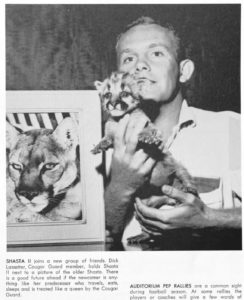
The debut of Shasta II next to a photo of her predecessor. (Houstonian)
Shasta Ⅱ was the university’s mascot from 1962-1965. She made her debut at just 5 weeks old at an October 1960 pep rally, and was in training until Shasta Ⅰ retired, at 14 years old. She had the shortest reign due to unruly, predictably cougar-like, behavior. A November 1964 article in The Cougar stated, “Although Shasta is bad-tempered, she is appreciated by the students. Besides, cougars are supposed to be mean. The students would like to see the meanness rub off on the UH football team.” She was the first cougar to reside on campus full time in Shasta’s Den, a small enclosure located in the southeast corner of Lynn Eusan Park. Shasta Ⅱ was retired to the Waco Zoo at 5 years old.
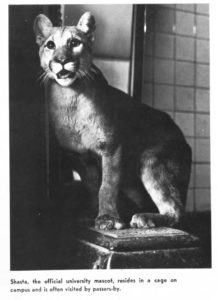
Shasta III, “The Lady,” rests in her on-campus enclosure. (Houstonian)
Shasta Ⅲ, a.k.a. “The Lady” served from 1965-1977, and may have been the most famous of all the university’s cougars. Along with being the university’s mascot, “The Lady” was featured in commercial spots for American Motors. Shasta Ⅲ made her mascot debut during the November 6, 1965 homecoming game. She became an official alumnus in 1977 and retired due to worsening arthritis. Shasta was pulled around the Astrodome in her wagon one last time during the UH Homecoming Game. An anonymous donation of $7,000 was made for a second enclosure for Shasta Ⅳ, so that Shasta Ⅲ could remain in her enclosure on campus. Shasta Ⅲ was one of the most beloved cougars that ever prowled university grounds, she even graces the 1975 cover of the Houstonian.
Shasta Ⅳ, a.k.a. “Baby Shasta” was promoted to university mascot when she was just 11 weeks old in 1977. However, when “Baby” grew up, the Cougar Guard could not control her, much like her predecessor Shasta Ⅱ. “Baby Shasta” retired in 1980 at the young age of three. Shasta Ⅳ did make a lasting impression on one of the Cougar Guard members charged with her care. Justin Leiber, an author, philosopher, and graduate of the University of Houston, was so impressed by Shasta Ⅳ that he made her a recurring character in two of his science fiction novels. An article in the 1989 Houstonian details their close relationship.
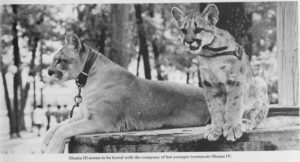
Shasta III and Shasta IV share reside together in their on-campus enclosure after an anonymous donation was made to expand the enclosure. (Houstonian)
Shasta Ⅴ made her debut on November 4, 1980. She held the position of beloved mascot for nine years when she was euthanized due to kidney failure in 1989. When Shasta Ⅴ’s reign came to an end there was much discussion over the ethics of housing a wild animal on campus and controversy amongst staff and students over the size of Shasta’s Den and her quality of life. There were even attempts to fundraise for a larger enclosure before Shasta Ⅴ’s passing. In 1989 Interim President George Magner ruled that the tradition of a live mascot would end with the death of Shasta Ⅴ, bringing a 42 year tradition to an end. The decision was made based on liability, funds, and animal exploitation/rights. However, the decision went against the majority opinion of the students at the time.
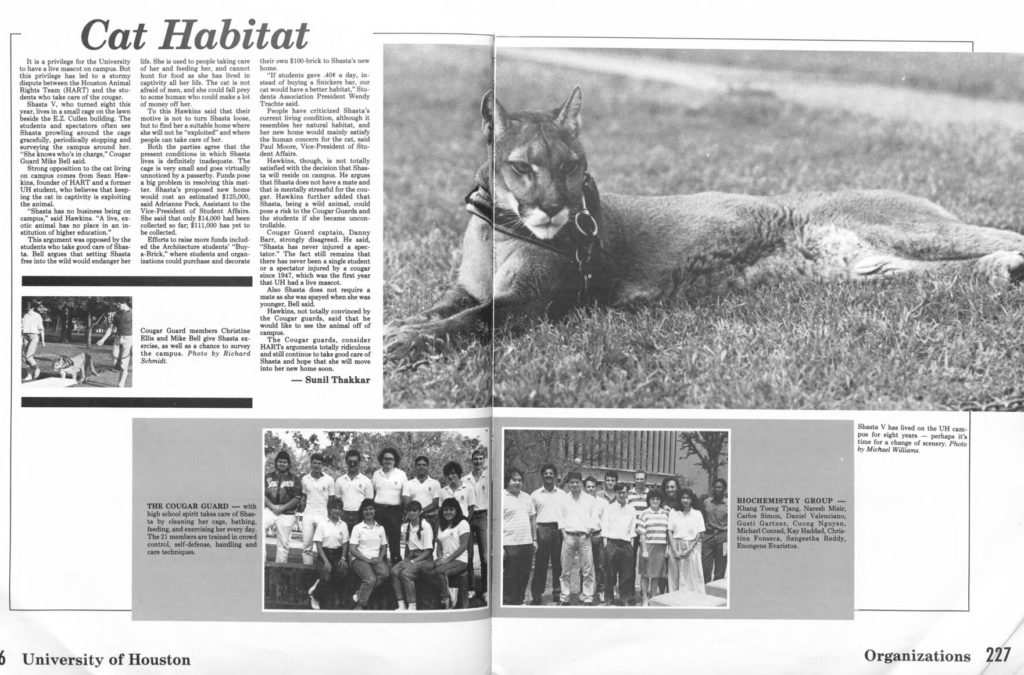
Shasta V appears in an article in the 1988 Houstonian debating the ethics of keeping a wild cougar on campus. (Houstonian)
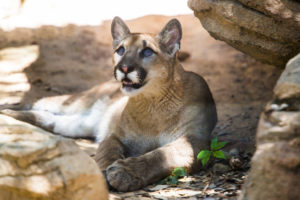
Shasta VI calls the Houston Zoo his home. (Houston Zoo)
It would be 22 years before UH was blessed with another iteration of Shasta. In 2011, the Houston Zoo rescued a cougar cub whose mother had been illegally killed in Washington State. How fitting that Shasta Ⅵ would come from the very place that inspired John R. Bender back in 1927. The zoo entered into a partnership with UH Alumni Association and on March 24, 2012 Shasta Ⅵ was introduced to the public and became an ambassador for the university. Shasta Ⅵ is the first live male cougar mascot. While Shasta Ⅵ resides exclusively at the Houston Zoo, he does attend important university events…via webcam. Before the biannual ring ceremonies, class rings spend the night in the cougar habitat to be blessed by Shasta. Students can visit Shasta Ⅵ at the zoo for free with a student ID.
The University of Houston’s Specially Collections Department has many resources that highlight Shasta Ⅰ-Ⅴ, including pictures and articles in archived versions of The Cougar and Houstonian.